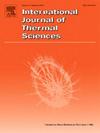基于真实肿瘤模型和优化加热方案的微波驱动给药肝细胞癌的计算研究
IF 4.9
2区 工程技术
Q1 ENGINEERING, MECHANICAL
International Journal of Thermal Sciences
Pub Date : 2025-07-09
DOI:10.1016/j.ijthermalsci.2025.110140
引用次数: 0
摘要
肝细胞癌(HCC)是最常见的肝癌形式,仍然是全球癌症相关死亡率的主要原因之一。现有的治疗方法如化疗和热消融面临着严重的局限性,包括肿瘤覆盖率不理想和高全身毒性。本文介绍了一种数值方法来研究脉冲微波热疗和热敏脂质体(TSL)给药的联合效应。建立了一个基于分割CT成像的三维计算模型来复制真实的肝脏肿瘤解剖结构。该模型模拟了药物扩散的时空变化,并结合了温度和组织损伤相关参数。结果表明,与传统化疗相比,脉冲热疗使细胞内阿霉素水平提高50.4%(从0.387 mol m−3提高到0.582 mol m−3)。此外,与连续加热相比,脉冲加热可显著减少热消融肿瘤体积(从35.5%降至18.6%)。使用解剖学上精确的几何结构可以更详细地分析肿瘤和组织形状不规则如何影响治疗结果和温度场扩散。这些结果强调了整合靶向药物载体和局部加热在推进肝癌个性化治疗中的潜力。本文章由计算机程序翻译,如有差异,请以英文原文为准。
Computational study of microwave-driven drug delivery with realistic tumor modeling and optimized heating protocols for hepatocellular carcinoma
Hepatocellular carcinoma (HCC), the most prevalent form of liver cancer, remains one of the top contributors to cancer-related mortality worldwide. Existing treatments like chemotherapy and thermal ablation face critical limitations, including suboptimal tumor coverage and high systemic toxicity. This study introduces a numerical approach to investigate the combined effects of pulsed microwave hyperthermia and thermosensitive liposomal (TSL) drug delivery. A 3D computational model was developed based on segmented CT imaging to replicate realistic liver tumor anatomy. The model simulates both spatial and temporal variations in drug diffusion, incorporating temperature and tissue damage-dependent parameters. Results indicate that pulsed hyperthermia enhances intracellular doxorubicin levels by 50.4 % (from 0.387 to 0.582 mol m−3) compared to traditional chemotherapy. Additionally, pulsed heating significantly reduces thermally ablated tumor volume (from 35.5 % to 18.6 %) relative to continuous heating. The use of anatomically accurate geometry allows for a more detailed analysis of how tumor and tissue shape irregularities influence therapeutic outcomes and temperature field diffusion. These results emphasize the potential for integrating targeted drug carriers and localized heating in advancing personalized treatment for liver cancer.
求助全文
通过发布文献求助,成功后即可免费获取论文全文。
去求助
来源期刊

International Journal of Thermal Sciences
工程技术-工程:机械
CiteScore
8.10
自引率
11.10%
发文量
531
审稿时长
55 days
期刊介绍:
The International Journal of Thermal Sciences is a journal devoted to the publication of fundamental studies on the physics of transfer processes in general, with an emphasis on thermal aspects and also applied research on various processes, energy systems and the environment. Articles are published in English and French, and are subject to peer review.
The fundamental subjects considered within the scope of the journal are:
* Heat and relevant mass transfer at all scales (nano, micro and macro) and in all types of material (heterogeneous, composites, biological,...) and fluid flow
* Forced, natural or mixed convection in reactive or non-reactive media
* Single or multi–phase fluid flow with or without phase change
* Near–and far–field radiative heat transfer
* Combined modes of heat transfer in complex systems (for example, plasmas, biological, geological,...)
* Multiscale modelling
The applied research topics include:
* Heat exchangers, heat pipes, cooling processes
* Transport phenomena taking place in industrial processes (chemical, food and agricultural, metallurgical, space and aeronautical, automobile industries)
* Nano–and micro–technology for energy, space, biosystems and devices
* Heat transport analysis in advanced systems
* Impact of energy–related processes on environment, and emerging energy systems
The study of thermophysical properties of materials and fluids, thermal measurement techniques, inverse methods, and the developments of experimental methods are within the scope of the International Journal of Thermal Sciences which also covers the modelling, and numerical methods applied to thermal transfer.
 求助内容:
求助内容: 应助结果提醒方式:
应助结果提醒方式:


